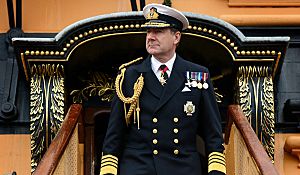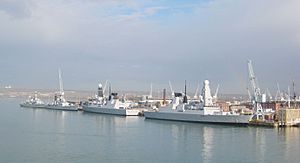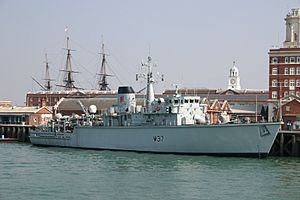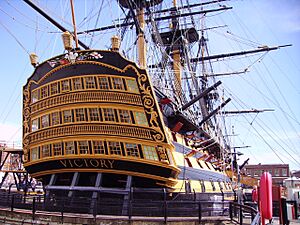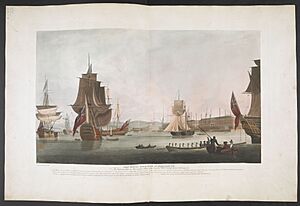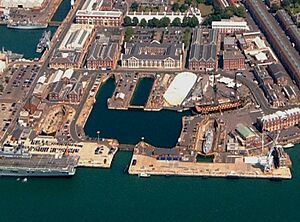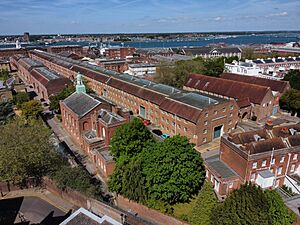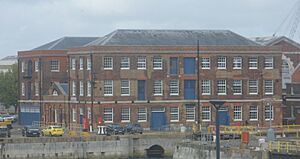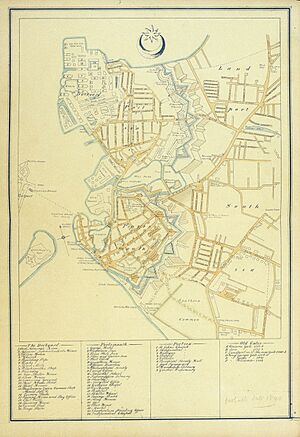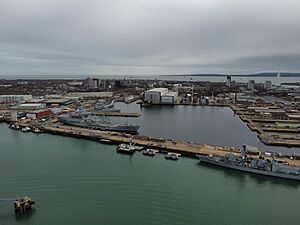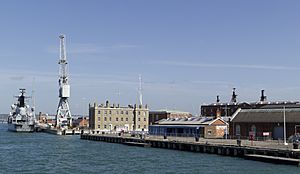HMNB Portsmouth facts for kids
Quick facts for kids HMNB Portsmouth
|
|
|---|---|
| Portsmouth, Hampshire, England | |
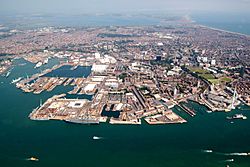
An aerial view of HMNB Portsmouth taken in 2005
|
|
|
Location in Hampshire
|
|
| Coordinates | 50°48′15″N 1°6′9″W / 50.80417°N 1.10250°W |
| Type | Naval base |
| Area | 122 hectares (300 acres) |
| Site information | |
| Owner | Ministry of Defence (Defence Equipment and Support) |
| Operator | Royal Navy |
| Controlled by | Naval Base Commander, Portsmouth |
| Condition | Operational |
| Site history | |
| Built | 1194 |
| In use | 1194–present |
| Events | International Festivals of the Sea (1998, 2001 & 2005) |
| Garrison information | |
| Current commander |
Commodore John Voyce OBE |
| Garrison | Portsmouth Flotilla |
His Majesty's Naval Base, Portsmouth (HMNB Portsmouth) is a very important home for the Royal Navy in the United Kingdom. It's one of three main bases, located in the city of Portsmouth, on the eastern side of Portsmouth Harbour. For hundreds of years, it was known as HM Dockyard, Portsmouth. It was a huge place where warships were built, fixed, and kept ready for action. At one point, it was the biggest industrial site in the world!
Since the 1970s, it's been called a 'Naval Base'. This shows that it's not just about building ships anymore. It's also about supporting the sailors and staff who work there. In 1984, the shipbuilding part of the dockyard became smaller. It was later privatized in 1998. While new ships were built there again for a short time in the 2000s, this stopped in 2014.
Today, Portsmouth is the home port for many of the Royal Navy's surface ships. This includes the two giant aircraft carriers, HMS Queen Elizabeth and HMS Prince of Wales. The base provides everything sailors need, like food, housing, medical care, and education. It also hosts companies like BAE Systems Maritime Services that help repair and maintain ships.
This naval base is the oldest in the Royal Navy. It has played a huge role in British history and defense for centuries. It has one of the oldest working drydocks in the world. The old Block Mills here were the first factory in the world to use steam-powered machines for mass production. The Royal Naval Museum has been on site since 1911. Part of the historic area is now the Portsmouth Historic Dockyard, where you can visit famous ships like the Mary Rose, HMS Victory, and HMS Warrior.
Contents
- How the Naval Base Works
- Portsmouth Historic Dockyard
- History of Portsmouth Naval Base
- Naval Base Commander (Portsmouth)
- Images for kids
Key Leaders at the Base
The main leader of HMNB Portsmouth is the Naval Base Commander (NBC). Since September 2024, this role has been held by Commodore Marcel Rosenberg. The King's Harbour Master (KHM) is in charge of the harbor itself. This area covers about 50 square miles (130 km²) of Portsmouth Harbour and the Eastern Solent. The KHM's team works from the Semaphore Tower building, guiding ships in and out.
For a long time, the Commander-in-Chief, Portsmouth lived in the Dockyard and used HMS Victory as his special ceremonial flagship. This tradition continued until 2012, when the First Sea Lord took over the role and the use of Victory.
Ships Based at Portsmouth
Many ships are based here, forming the Portsmouth Flotilla. Some patrol vessels are part of this group but might be deployed elsewhere.
Historic Flagship: HMS Victory
- HMS Victory is a famous old warship.
Powerful Aircraft Carriers
- HMS Queen Elizabeth
- HMS Prince of Wales
Type 45 Destroyers
These are modern, powerful warships.
- HMS Daring – getting ready to return to the fleet in 2024.
- HMS Dauntless
- HMS Diamond
- HMS Dragon – being refitted, expected back by late 2024.
- HMS Defender – undergoing a major upgrade until 2026.
- HMS Duncan
Type 23 Frigates
- HMS Lancaster (currently serving in Bahrain until 2025).
Some other Type 23 frigates that used to be based here have moved to HMNB Devonport or have been retired.
Hunt-class Minehunters
These ships help find and clear underwater mines.
- HMS Ledbury
- HMS Cattistock
- HMS Brocklesby
- HMS Middleton – works from Bahrain.
- HMS Chiddingfold
- HMS Hurworth
Mine Countermeasures Mothership
- HMS Stirling Castle (will support autonomous mine-hunting vessels).
River-class Patrol Vessels
These ships patrol and protect waters around the UK and overseas.
- HMS Tyne – for fishery protection.
- HMS Severn – for fishery protection.
- HMS Mersey – for fishery protection.
- HMS Forth – serving in the Falklands since 2019.
- HMS Medway – serving in the Caribbean since 2020.
- HMS Trent – serving from Gibraltar since 2021.
- HMS Tamar – serving in the Indo-Pacific region since 2021.
- HMS Spey – serving in the Indo-Pacific region since 2021.
Cutlass-class Patrol Vessels
- HMS Cutlass – assigned to the Gibraltar Squadron.
- HMS Dagger – assigned to the Gibraltar Squadron.
Archer-class Patrol Vessels
These are smaller patrol boats often used by university naval training units.
- HMS Blazer
- HMS Exploit
- HMS Puncher
- HMS Ranger
- HMS Smiter
Experimental Vessel
- XV Patrick Blackett (used for testing new naval technologies since 2022).
Diving Support Boats
- 3× Sea-class 15-meter diving support boats for the Defence Dive School.
Portsmouth Historic Dockyard
The Portsmouth Historic Dockyard is a special part of the naval base that is open to the public. It's like a living museum where you can explore amazing maritime history.
- The Mary Rose: This is a famous Tudor warship that sank in 1545 and was raised in 1982. You can see its remains in a modern museum building.
- HMS Victory: This is Nelson's flagship from the Battle of Trafalgar. It's still a commissioned ship but is open for visitors.
- HMS Warrior (1860): The world's first ocean-going Ironclad warship, built in 1860.
- HMS M33: A World War I monitor warship, opened to the public in 2015.
- National Museum of the Royal Navy: One of the best maritime museums in the world. It has exhibits like the Trafalgar Sail from Victory.
- Action Stations: An interactive center with exhibits about naval science and simulators.
- The Dockyard Apprentice exhibition: Tells the story of working life in the dockyard.
- Portsmouth Harbour Tours: Boat tours that show you the historic dockyard from the water.
- Boathouse 4: Opened in 2015, it tells the story of the Navy's small boats and is an active boat-building site.
Portsmouth has been a key naval base for the Royal Navy for centuries, alongside other important dockyards like Woolwich and Chatham.
Early Beginnings
The first dock was ordered by Richard I in 1194. Later, King John added walls in 1212. These docks were used by kings for invasions of France in the 13th and 14th centuries.
Tudor Era Innovations
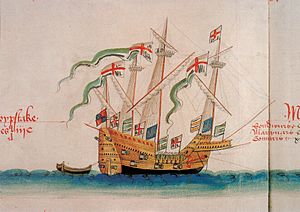
In 1495, Henry VII built the world's first recorded dry dock here. Famous warships like the Mary Rose (1509) and Peter Pomegranate (1510) were built and rebuilt in Portsmouth. The Mary Rose sank in 1545 but was raised in 1982 and is now a museum exhibit.
Growth in the 1600s
Shipbuilding started again in Portsmouth in 1648. A new double dry dock was built in 1656. In 1664, a new mast pond was dug to store timber for ship masts. Between 1665 and 1668, the dockyard was fortified with earthen walls to protect it.
Amazing Engineering by Edmund Dummer
As France became a bigger threat, Portsmouth's importance grew. In 1689, a new dry dock was ordered, big enough for the largest warships. Edmund Dummer designed this "Great Stone Dock," using brick and stone instead of wood. This was a new and clever design. He also planned two wet docks (basins that didn't change with the tide). One of these, now called "No. 1 Basin," is still in use today.
Dummer also created a unique system to empty the dry dock. It used water from one of the wet docks to power a water-wheel and pumps. By 1700, Portsmouth Dockyard was a very advanced place for shipbuilding.
The 1700s: Expansion and New Buildings
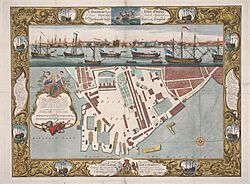
Between 1704 and 1712, a brick wall was built around the dockyard, much of which still stands. In 1733, the first shore-based training facility for naval officers, the Royal Naval Academy, was set up here.
The second half of the 1700s saw a "Great Rebuilding" of the dockyard. This was because ships were getting bigger and the fleet was growing. New dry docks were built, and the Great Basin was deepened. Many important historic buildings, like the three large storehouses (Nos 9, 10 & 11) and the Great Ropehouse, were built during this time. The Ropehouse was where long ropes for ships were made.
In 1784, a large new house was built for the Dockyard Commissioner. A new chapel, St Ann's Church, was also built.
Samuel Bentham and the Industrial Revolution
In 1796, Samuel Bentham was put in charge of modernizing the Royal Dockyards. He brought in many new ideas and inventions. He designed the first successful steam-powered bucket dredger to work in the harbor in 1802.
Bentham also oversaw the building of new stone dry docks (Nos 2 and 3 docks, still used today). He used Smeaton's waterproof cement for these projects. In 1797, he suggested using a steam engine to drain the reservoir and power machinery. This was the first time steam power was used in a Royal Naval Yard.
Between 1802 and 1808, the famous Portsmouth Block Mills were built. Here, Marc Brunel (father of Isambard Kingdom Brunel) designed machines that made ships' pulley blocks. This was the world's first steam-powered factory for mass production!
The 1800s: Steam Power and Huge Expansion
By 1800, the Royal Navy had 684 ships, and Portsmouth Dockyard was the biggest industrial site in the world. In 1805, Nelson visited the new block mills before sailing from Portsmouth on HMS Victory for the Battle of Trafalgar.
The invention of steam propulsion for warships changed everything. In 1843, work began to create a new 7-acre (2.8-hectare) basin (No 2 Basin) and a large factory to build and repair marine steam engines. This "Steam Factory" had many workshops and was powered by an 80-horsepower steam engine.
The Great Extension
By 1860, wooden warships were outdated. Ships were now made of metal, and they were much bigger. To keep up, Portsmouth Dockyard underwent a "Great Extension" from 1867. This involved building three new interconnected basins and three new dry docks. A large pumping station was built in 1878 to drain these docks and power equipment.
New, huge buildings were also constructed for manufacturing, like a workshop for making gun turrets and a torpedo workshop. By the end of the century, even more dry docks were added to handle the ever-growing size of naval vessels.
The Dockyard Railway
In 1843, a railway system was built within the dockyard. It connected to the main railway line in 1846. By 1952, there were over 27 miles (43 km) of track! A special railway station was built in 1876 for important visitors, including Queen Victoria and her family, who would often travel by yacht and then switch to a train here.
The 1900s: Dreadnoughts and World Wars
Building Dreadnoughts
The first modern battleship, Dreadnought, was built here in just over a year (1905–06). Many other powerful battleships, called dreadnoughts, followed. The dockyard also got electricity with a new power station in 1906.
The largest naval ships became too big for the old basins. So, the walls between the basins were removed to create one large body of water (No 3 Basin). Two huge entrance locks, C & D locks, were built and opened in 1914. These are still used today.
World War I and II
During World War I, the battleship Royal Sovereign was launched here in 1915. Many other ships were refitted and repaired at Portsmouth. Women also started working in the dockyard in large numbers during the war.
In 1922, HMS Victory was moved into No 2 Dry Dock, where it remains today as a museum ship. The "Semaphore Tower" was rebuilt in 1930 after the original was destroyed by fire.
During World War II, Portsmouth was vital for defending the English Channel and was heavily bombed. It was also the main departure point for military and naval units heading to Sword Beach for the D-Day landings on 6 June 1944. The base helped build landing craft and other support vessels.
After World War II
After the war, the dockyard was busy rebuilding and refitting ships. However, in 1966, a plan to reduce the size of the fleet meant fewer jobs at the dockyard. Shipbuilding eventually stopped in Portsmouth.
The Falklands Conflict
In 1982, Argentina invaded the Falkland Islands. Portsmouth Naval Base quickly prepared a task force of British ships to sail to the South Atlantic and reclaim the islands.
The task force included aircraft carriers, destroyers, frigates, submarines, and many other military and merchant ships. Most of these ships returned to Portsmouth later that year after successfully completing their mission.
After the Falklands War, some of the planned cuts to the dockyard were changed. However, many old dry docks and workshops were still closed or converted for other uses. In 1998, the ship repair and maintenance work was taken over by a private company.
The 2000s: New Carriers and Modernization
In 2005, Portsmouth Naval Base hosted special events for Trafalgar 200, celebrating 200 years since the Battle of Trafalgar.
Shipbuilding and Maintenance Today
Shipbuilding started again in Portsmouth in 2003 for a short time. New facilities were built to construct parts of the Type 45 destroyers and Queen Elizabeth-class aircraft carriers. However, this shipbuilding stopped in 2013 due to budget changes.
BAE Systems now manages ship repair and maintenance at Portsmouth. The former shipbuilding complex is used for repairing minehunters and other smaller ships.
Home for New Aircraft Carriers
In 2013, a £100 million upgrade of the naval base began. This was to prepare for the arrival of the two new Queen Elizabeth-class aircraft carriers, which would be based here. The harbor was deepened, and jetties were strengthened. HMS Queen Elizabeth arrived in Portsmouth in 2017, and HMS Prince of Wales followed two years later.
The person in charge of HMNB Portsmouth is called the Naval Base Commander (Portsmouth). Here are some of the people who have held this important role:
- 1996–1998: Commodore I.R. Henderson
- 1998–2000: Commodore S.W. Graham
- 2000–2002: Commodore R.P. Bossier
- 2002–2005: Commodore A.M. Hussain
- 2005–2008: Commodore David Steel
- 2008–2011: Commodore Rick Thompson
- 2011–2012: Commodore Tony Radakin
- 2012–2018: Commodore Jeremy Rigby
- 2018–2019: Commodore Jim Higham
- 2019–2022: Commodore Jeremy Bailey
- 2022–2024: Commodore John Voyce
- 2024–present: Commodore Marcel Rosenberg
Images for kids
-
A Geometrical Plan & West Elevation of His Majesty's Dock-Yard near Portsmouth by Thomas Milton, 1754.
-
Former Smithery (left, 1791-4).



